<< Previous | Displaying results 6051-6075 of 6769 for "" | Next >>
The SS ordered Jews to undress prior to the mass shootings at the nearby Babyn Yar killing site. In two days, September 29-30, 1941, they shot more than 33,000 Jews from Kyiv (Kiev). This photograph, taken by a member of a German Propaganda Company, shows just some of the belongings of these victims. Kyiv, German-occupied Soviet Union, After September 30, 1941.
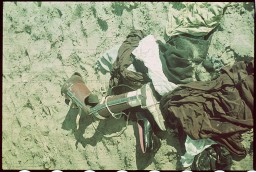
Clothing belonging to Jewish victims murdered by the SS at the nearby Babyn Yar killing site. Prior to the mass shootings, the SS ordered Jews to undress and leave their belongings. They then marched or drove the victims to the killing site. A German photographer took this image within days of the mass shootings. Kyiv (Kiev), German-occupied Soviet Union, after September 30, 1941.
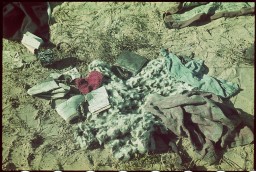
An SS guard examines piles of clothing belonging to the more than 33,000 Jews murdered at the nearby Babyn Yar killing site. The SS forced the victims to undress and leave their belongings behind. The Jews were then marched or driven to the shooting site. Kyiv (Kiev), German-occupied Soviet Union, after September 30, 1941.
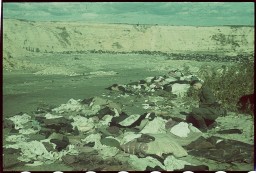
SS men search through massive piles of clothing belonging to the more than 33,000 Jews murdered at the nearby Babyn Yar killing site. The SS forced the victims to undress and leave their belongings behind. The Jews were then marched or driven to the shooting site. Kyiv (Kiev), German-occupied Soviet Union, after September 30, 1941.
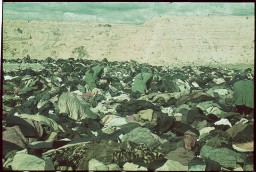
SS men or German police officers on one of the sandy cliffs near the Babyn Yar killing site. Below them are unidentified men, perhaps Soviet prisoners of war or local Ukrainians, who sorted through the huge piles of clothing belonging to the more than 33,000 Jews from Kyiv (Kiev) who were murdered at Babyn Yar. Kyiv, German-occupied Soviet Union, after September 30, 1941.
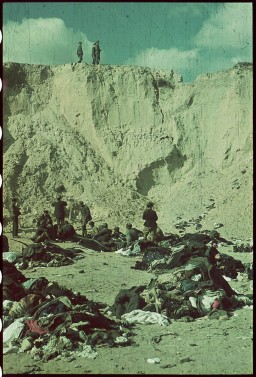
Léon Degrelle, an extreme right-wing Belgian politician and Nazi collaborator. Photo dated 1933–1945.
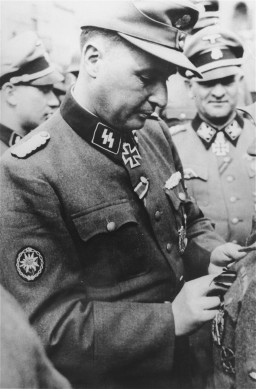
Staff member Johann Niemann in his room at the Bernburg "euthanasia" center. For the picture, he turned his family photo on the bedside table in the direction of the photographer. Niemann later became the deputy commandant of Sobibor, one of three "Operation Reinhard" killing centers.
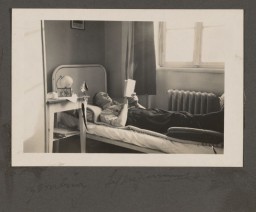
Belgian politician Léon Degrelle (center) stands in formation with fighters from the Belgian Volunteers who are on their way to fight in the Soviet Union. Belgium, August 15, 1941. During World War II, Degrelle founded a collaborationist military force that fought on the eastern front.
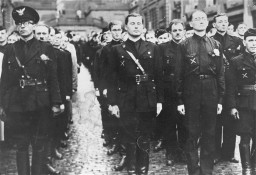
Lucie Lind shopping in an open-air market in Lwów, Poland, sometime in the 1930s. Lucie was born into an affluent Jewish family on January 23, 1909. At the time, Lwów (Lemberg) was part of the Austro-Hungarian Empire. Lucie was educated in Vienna. Before World War II, she was a housewife. Her first husband was a well-known artist throughout Europe. The couple’s daughter was born in 1936. Lucie’s fashionable clothes, hat, and gloves are typical for middle or upper class women living in Poland at the…
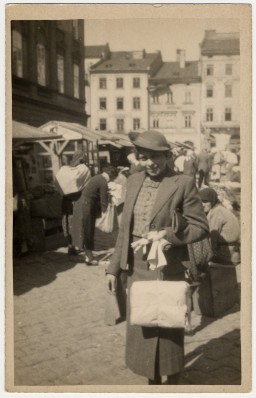
Wartime portrait of Andrzej Klimowicz, Poland. Andrzej Klimowicz (1918–1996) aided and rescued Jews in Warsaw throughout the duration of the German occupation of Poland. He eventually became a member of the Council for Aid to Jews (codenamed “Żegota”), a clandestine organization that coordinated efforts to save Jews from Nazi persecution and murder. Under the auspices of Żegota, Andrzej played a role in providing Jews in Warsaw with forged identity papers and hiding places outside the walls of the…
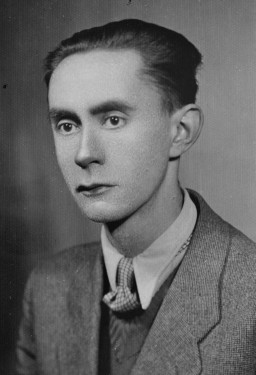
A color photograph of Eva Justin interviewing a Romani woman interned in a "Gypsy camp." Vienna, Austria, 1940. During the Nazi era, Dr. Robert Ritter was a leading authority on the racial classification of people pejoratively labeled “Zigeuner” (“Gypsies”). Ritter’s research was in a field called eugenics, or what the Nazis called “racial hygiene.” Ritter worked with a small team of racial hygienists. Among them were Eva Justin and Sophie Ehrhardt. Most of the people whom Ritter studied and…
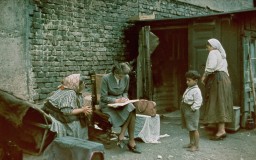
Portrait of Irena Sendler in Warsaw, Poland, circa 1939. Irena Sendler (1910–2008) was a member of the Council for Aid to Jews, codenamed “Żegota.” Żegota was a clandestine rescue organization of Poles and Jews in German-occupied Poland. Supported by the Polish government-in-exile, Żegota coordinated efforts to save Jews from Nazi persecution and murder. It operated from 1942 to 1945. Irena Sendler (Sendlerowa) was working as a social worker in Warsaw when World War II broke out in 1939. After…
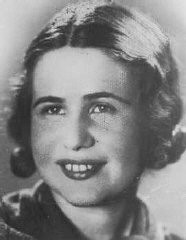
Portrait of Władysław Bartoszewski, Poland, unknown date. Władysław Bartoszewski (1922–2015) was a co-founder and member of the Council for Aid to Jews, codenamed “Żegota.” Żegota was a clandestine rescue organization of Poles and Jews in German-occupied Poland. Supported by the Polish government-in-exile, Żegota coordinated efforts to save Jews from Nazi persecution and murder. It operated from 1942 to 1945. After World War II broke out in September 1939, Władysław worked as a janitor…
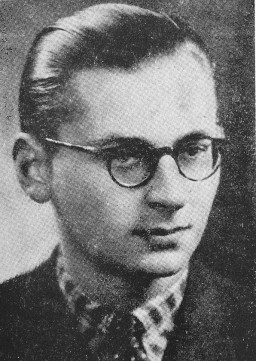
Visitors view the exhibition of the Arrow Cross newspaper, Pesti Ujság, at the International Fair in Budapest. The headline reads: "For a Hungary without Jews." Budapest, Hungary, approximately 1941-1942. The Arrow Cross was Hungary's largest fascist political movement after 1935. In the 1939 parliamentary elections it won over 20% of the vote and had more than 250,000 members. Its ideology was ultra-nationalistic and fiercely antisemitic. The Arrow Cross viewed Jews as an "anti-national" "race"…
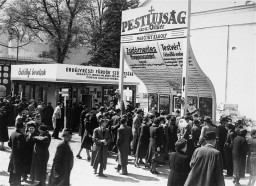
Election officers count votes late into the night after the second round of the 2006 presidential and provincial elections in Bunia, Ituri, Democratic Republic of the Congo.

The United Nations Diplomatic Conference of Plenipotentiaries on the Establishment of an International Criminal Court opened a five week session on June 15, 1998, in Rome, Italy.
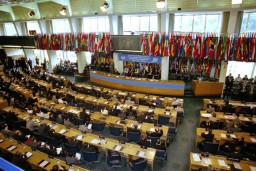
Schoolchildren wait in anticipation for the arrival of the US Ambassador to the United Nations and members of the UN Security Council, who have traveled to South Sudan to underscore their support for the January referendum on the region’s independence. October 9, 2010.
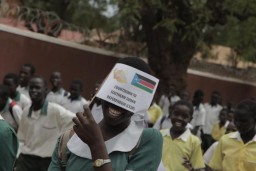
William Proxmire (1915–2005) served in the United States Senate for the state of Wisconsin from 1957 to 1989. Senator Proxmire was one of the strongest advocates for the UN Convention on the Prevention and Punishment of Genocide, which was ratified by the United States in 1988.

Images from a German publication about the occupation of the Rhineland (1918–1930), a region in western Germany, and multiracial children who were born to white German mothers and Black soldiers there. Publication dated 1936–1939.
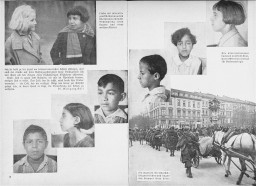
The daughter of a white German woman and a Black French soldier stands among white classmates, Munich, 1936. This image was included as a slide for lectures on genetics, ethnology, and race breeding at the State Academy for Race and Health in Dresden, Germany.

Prewar portrait of Golda Tenin with her daughter Paulina, 1935. The Tenin family was living in the Ukrainian city of Odesa when it was occupied by Romania, an ally of Nazi Germany. In December 1941, Romanian authorities decided to make Odesa free of Jews. Two of Golda's children, Paulina and Rita, were murdered. Paulina was killed in January 1942, likely during deportation. Rita was killed after she was discovered in hiding with non-Jewish neighbors. Golda managed to survive.
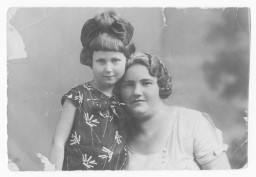
Garber family photograph, likely taken in Zehlendorf, Berlin, circa 1946. Magdalene Garber and her husband Jack Goodwin (an African American GI) had a house in Zehlendorf. This photo was most likely taken in their garden. Standing left to right are Käthe Garber (‘an aunt’ according to the original caption), Magdalene, Joseph Garber, and Helga Naue (future wife of Hans Garber). The man kneeling is Hans Garber (Magdalene's brother). Joseph is wearing Jack Goodwin’s hat (Magdalene's…
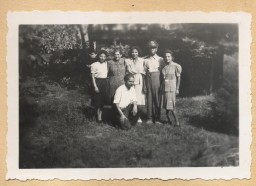
Josefa Boholle (Josefa van der Want after marrying her husband in 1943) sitting on the steps of a circus wagon with a bird on her shoulder. The photo was likely taken in Eisleben, Saxony-Anhalt, Germany, around 1936-1937. During World War II, Josefa and her Dutch husband were imprisoned in the Stutthof concentration camp. The official reason given for their arrest was for listening to foreign radio broadcasts. However, it is likely that the couple’s resistance activities and their interracial marriage…
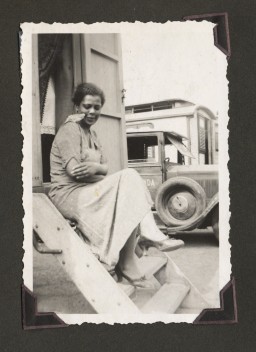
Members of the German Africa Show (Deutsche Afrika-Schau), circa 1937 in Germany. Though these early shows were exploitative by nature, artists originally had the ability to shape their own performances and how they were represented. After the Nazis came to power in 1933, this agency began to disappear. During the Nazi era, working in such shows was an increasingly propaganda-driven, demoralizing, and unpleasant experience. Known persons in the photograph from left to right: Josef Boholle is the furthest…
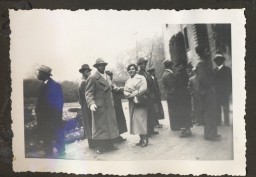
A group of female performers from the German Africa show (Deutsche Afrika-Schau) sitting on a circus wagon. This photo was likely taken in Eisleben, Saxony-Anhalt, Germany, around 1936-1937. Though early ethnographic shows like the Deutsche Afrika-Schau were exploitative by nature, artists originally had the ability to shape their own performances and how they were represented. After the Nazis came to power in 1933, this agency began to disappear. During the Nazi era, working in such shows was an…
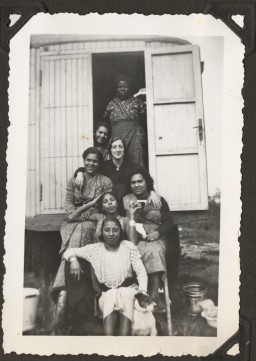
We would like to thank Crown Family Philanthropies, Abe and Ida Cooper Foundation, the Claims Conference, EVZ, and BMF for supporting the ongoing work to create content and resources for the Holocaust Encyclopedia. View the list of donor acknowledgement.